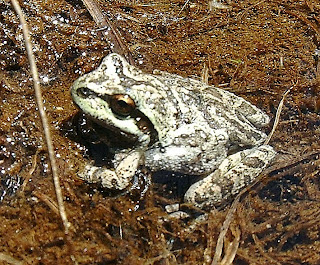Last week, the journal PLoS ONE published an interesting paper by Natalie Reeder and colleagues that suggested a potential role for the Pacific chorus frog (Pseudacris regilla) as a carrier of the amphibian chytrid fungus (Batrachochytrium dendrobatidis; "Bd"). Numerous media outlets covered the paper (e.g., San Francisco Chronicle), which in essence just adds a few details to a phenomenon that was already reasonably well-known. That is, chorus frogs can carry high-intensity Bd infections while showing few symptoms of disease (i.e., chytridiomycosis). As such, they appear to be more tolerant of chytridiomycosis than other amphibian species. For example, mountain yellow-legged frogs typically die when their Bd infection intensities approach 10,000 zoospore equivalents (2010 paper by Vredenburg and colleagues). In contrast, most chorus frogs in the Reeder study maintained infections at this level but showed few of the typical disease symptoms (excessive skin sloughing, lethargy, etc.) that result from Bd-caused changes to the frogs' skin.
The apparent ability of chorus frogs to carry high-level Bd infections without suffering significant negative effects could make this species an effective carrier of Bd. That is potentially important in the Sierra Nevada, where chorus frogs and mountain yellow-legged frogs often exist in the same habitats. Could chorus frogs be responsible for spreading Bd to formerly uninfected mountain yellow-legged frog populations? This remains a distinct possibility, but it would still be only part of the story. For example, I've documented numerous successful invasions of Bd into mountain yellow-legged frog populations despite mountain yellow-legged frogs being the only amphibian species present. Without any chorus frogs in the vicinity, how did Bd disperse into these populations? We don't know, but clearly Bd is able to do so in the absence of chorus frogs.
It also remains unknown how chorus frogs are able to tolerate these intense Bd infections. But the Reeder paper does provide an interesting observation. That is, some of the heavily infected frogs had highly localized Bd infections in which most of the skin surface was uninfected and a few areas were highly infected. That should allow normal skin functions to continue, with little impact on frog physiology. It remains to be seen how general this result is in chorus frogs because only a few of the study frogs showed this pattern of infection, but it does suggest interesting avenues for future research.
Back to The Mountain Yellow-legged Frog Site.
March 19, 2012
Subscribe to:
Post Comments (Atom)




Hi.. so you're saying what? If there aren't chorus frogs in some of your areas where the MYLF are infected, I'm missing the point other then the chorus frog might be genetically able to stave off the infection. You're not saying we genetically alter the MYLF?
ReplyDeleteMy point was simply that if mountain yellow-legged frogs in an area become Bd-positive despite the absence of chorus frogs in the vicinity, that clearly indicates a role for a Bd carrier besides chorus frogs. Based on the patterns of Bd spread that I've documented, I'll put my money on aquatic insects being one of those carriers.
ReplyDeleteJust out of curiosity, are these Pacific Chorus Frogs native to the areas where they co-exist with the yellow legged frogs?
ReplyDeleteYes, the chorus frogs are native to the areas where their distribution overlaps with mountain yellow-legged frogs. They have a very wide distribution in California and throughout the western U.S., from sea level to the alpine zone.
DeleteIn 3rd grade, I had a report card that said "why is George often absent of Friday?" (The answer, of course, was that if I was absent on Thursday, I wouldn't get a 3 day weekend... Duh!).
ReplyDeleteSo now reading "Pacific Chorus frog" I can only assume the memo changing their name from Pacific Tree Frog was issued on a Friday.
Seems like we need an equally appealing name for the yellow-legged. The Prince Charming Frog? Hmmm. Needs work.
g.
Hi George. The taxonomy of treefrogs/chorus frogs has been the subject of much debate during the last 10 years, but the uncertainty seems largely resolved now. When Hyla regilla was reclassified as Pseudacris (~10 years ago), it went from being called the Pacific tree frog to being called the Pacific chorus frog. More recently, Pseudacris regilla was split into three separate species. In California, those in the southern part of the state are now called the Baja California treefrog (P. hypochondriaca), and those in the central part of the state are called the Sierran treefrog (Pseudacris sierra). The name P. regilla now refers only to the frogs in the Pacific northwest. The latest common and scientific names of amphibians can be found here: http://www.ssarherps.org/pages/comm_names/Index.php.
ReplyDeleteIn my post, I should have used "treefrogs" to be consistent with the latest taxonomy.